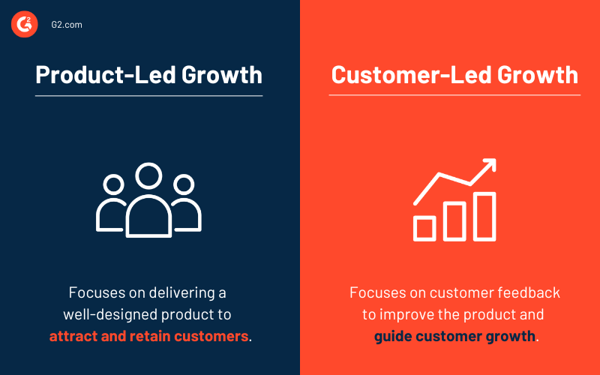Even as a newly minted organization, UpContent knew that the customer voice is a critical component of their company strategy.
This customer-first mindset has enabled UpContent to not only leverage their G2 profile as a place for prospects to see customer reviews but also as a hub for internally capturing customer feedback. This feedback is crucial to take a pulse check on how their customers feel and inform the direction of their product roadmap.
This all plays into UpContent’s customer-led growth (CLG) strategy.
I spoke with UpContent’s CEO Scott Rogerson and Content Manager Bethany Dameron to discuss how they’ve implemented a CLG approach, why it’s important to their business, and how others can find value by listening to the customer voice.
A customer-led growth approach
While product-led growth can be a powerful strategy for larger businesses, smaller companies may benefit from having a customer-led growth approach. This is because many smaller organizations simply do not have the resources or customer base to implement a product-led approach.
However, any size company can use customer feedback.

Customer-led growth is a strategy that helps companies take into account what customers are saying, find ways to incorporate it, and continuously improve their products as a result of customer feedback.
This involves a lot of listening on the company's part to get a deep understanding of the customers’ needs and how they can fulfill them. That’s where G2 comes into play.
“We see G2 Reviews as assets for us that we can pull value from.”
Scott Rogerson
CEO at UpContent
UpContent uses reviews as much as possible on a company-wide level. They have the G2 Reviews + Slack Integration set up so that when new reviews come in, all of their teams are immediately alerted to them.
Reviews help every department better understand their customers. Customer success tries to make a connection to the reviewer, even if they review anonymously, to get further information about their experience. Content teams use reviews to better understand industry terms and unique use cases.
At times, sales will send out reviews instead of full-length case studies to get their point across more succinctly. With G2, they can filter specific firmographics to see reviews from people similar to the potential customers they’re speaking with.
Ask anyone and everyone
One tip is to ask all customers for reviews, no matter what they say. Not asking a customer for a review because you think they will leave a bad one means that you aren’t fully capturing your customers’ voice.
UpContent asks its customers for reviews quarterly – and it's not based on what NPS score they leave, but rather the number of activities the customer performs. For example, any customer that has at least six sessions in their account will be asked to leave a review.
This is especially important since their product team looks at their reviews for improvements. Without hearing the negative, they would never know what needs to be refined. Additionally, other customers may feel the same way, and this one critique may help enhance the product for many more people.
As CEO, Scott takes the time to personally respond within a week to every review that’s left to thank the reviewer. He feels that it’s important that the reviewer recognizes the person responding to them so that they can build upon the existing relationship, and the conversation can continue if needed.
Rogerson views bad reviews as a step toward growth and change.
“My view is that it's the review answers, not the stars, that are most helpful, whether it's positive or negative.”
Scott Rogerson
CEO at UpContent
He appreciates that, because of the structure of the G2 review form, negative reviews include what the users do like about the product, and that good reviews also include something they don’t like. Even if UpContent does get a five-star rating, customer success will often probe the reviewer and ask if there’s anything that they could improve.
After all, nothing is perfect.
CLG in action
While some companies focus on lead generation and prospecting for their G2 profiles, UpContent is focused on listening to their customers first.
Their product team meets weekly to discuss the concerns of their customers. There’s also a weekly prioritization meeting to make changes to the roadmap based on feedback.
These meetings are not just about what’s liked or what could be improved – instead, they explore what a change to their product would look like if it were better, and how to bring that to life.
If there’s a new complaint, that’s a sign to keep an eye on it. If one person has a negative interaction with the product, then more people could be experiencing the same thing.
Finding the right fit
Learning about and discovering the right customers for their product is of the utmost importance. Asking questions like, “What type of customer do we want to attract?” and “What kind of customer works best with our tool?” helps shape UpContent’s marketing and sales strategy.
Dameron adds that the G2 comparison tool makes it simple to know which customers should go with UpContent’s product over their competitors.
“With the G2 comparison tool, it makes it easy to know if users should go here or elsewhere. Or they see that we're actually a really great fit.”
Bethany Dameron
Content Manager at UpContent
Even if, at the time, UpContent isn’t the software a potential customer chooses, Rogerson says they usually come back around. He’d rather have fewer right customers than more of the wrong.
A little advice on implementing CLG
Rogerson does have some advice for companies that are new to G2 and reviews.
1. Go into review generation with the right frame of mind. "With G2, you shouldn’t expect immediate results,” Rogerson cautions. It’s all about the long game. Start on year one and expect to see a great return by year two or three. Be active and don’t wait and try to catch up – reviews are something that needs to be built and collected over time.
2. Reviews are assets. Never be afraid to ask for feedback. It’s vital for the success of your product and your users. Rogerson adds, “Hopefully, seeing responses to reviews makes other customers want to leave a review. It's like writing a letter to Santa. Get a response, and you're gonna write again next year.”
3. G2 is an investment. Rogerson views G2 as a place for investing rather than an operating expenditure. UpContent doesn’t look at the number of leads generated to evaluate the success of their profile, they focus on what their customers are saying.
It's all about the journey
Having the materials and resources to show updates to your product and your product’s journey is vital. This allows you to see how much you’ve grown and how you’ve addressed any concerns that have come up in reviews.
This, in turn, shows your customers that you take their feedback seriously.
By embracing the power of the customers’ voice, businesses can make better decisions and create better products for their target market. It's important when embarking on a customer-led growth path with G2 to be patient, gather feedback through active listening, and continually evaluate what can be tweaked for improvement.
Interested in taking a CLG approach with your customers but unsure where to start? Your customers can share genuine, trusted feedback about your products and services with G2 Review Generation.
 by Savan Kharod
by Savan Kharod
 by Claire McGregor
by Claire McGregor
 by Cristina Maria
by Cristina Maria